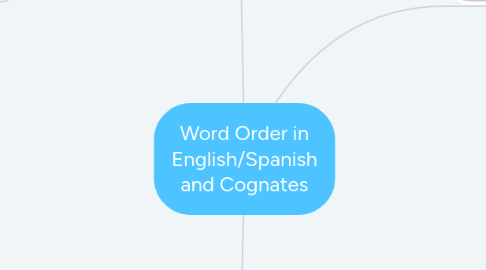
1. Word order in English
1.1. Normal word order
1.1.1. Subject verb object/complement
1.2. Inverted (Verb subject) word order
1.2.1. a. Question
1.2.2. b. Sentences beginning wirh "there"
1.2.3. c. Sentences beginning wirh "it"
1.2.4. d. Sentences beginning wirh place expression + an intransitive verb.
1.2.5. e. Sentences beginning wirh negative word
1.2.6. f. Conditional sentences
1.3. Word order of direct and indirect object
1.4. Word order Patterns considerations
1.4.1. Expressions of time can be put at the beginning or end of the sentence.
1.4.2. Move from specific to general when there are more than two expressions of time or place.
1.4.3. Det/# Opinion Value Size Shape Age Colour Cond/ Pattern Texture Origin Material Noun
1.4.4. Varying sentence openings: If they come first in the sentence, you must separate them using commas. Time word or phrase, prepositional, phrase of time or place, Transition expression, Infinitive phrase,Adverb, Adverb clause, ing/-ed phrase
1.5. Key points to remember about Word order in English
1.5.1. Adjectives often come before the noun.
1.5.2. Adjectives can also be placed at the end of a sentences by using a stative verbs.
1.5.3. The adverb is placed at the beginning of the sentence before the subject, but the subject still comes before its verb.
1.5.4. Adverbs and adverb phrases can be placed in three places in a sentence
1.5.4.1. At the front of the sentence, before the subject
1.5.4.2. At the end of a sentence, after the object.
1.5.4.3. In the middle of a sentence (before or after the verb) or in the middle of a group of verbs
1.5.5. Most adverbs can be placed in any of the positions in a sentence without changing the meaning of the sentence.
1.5.6. However, the placement of some adverbs can greatly change the meaning of a sentence.
2. Cognates
2.1. Cognates and False cognates
2.1.1. Cognates are words in two languages that share a similar meaning, spelling, and pronunciation.
2.1.2. Perfect cognates
2.1.2.1. as words that are spelt exactly the same in Spanish and English except for maybe an accent over one letter and they mean the same thing in both languages.
2.1.2.2. English Spanish Actor Actor Admirable Admirable Agenda Agenda Alcohol Alcohol
2.1.3. False cognates or false friends
2.1.3.1. They are words that are spelt the same or similar but mean completely different things.
2.1.3.2. English Spanish Advertisement advertencia Assist asistir Carpet carpeta College colegio
2.2. Cognates and False cognates considerations
2.2.1. False cognates should be taught in the beginner levels in order to avoid future confusions and embarrassments.
2.2.2. To avoid confusing these words give words within a context. This is an useful strategy to avoid getting confused by the false cognates.
2.2.3. Cognates are e the words that are easiest to learn because they’re similar to the words you already know, because they’re descended from the same root word. Romance languages — they descend from Latin. From Latin importans. Clearly, if you were learning the word in any of these languages, you wouldn’t even bother ‘learning’ it.
3. Orden de palabras en español
3.1. Tipos principales de orden
3.1.1. Orden natural
3.1.1.1. Sujeto-Verbo-Objeto-Complementos adverbiales
3.1.2. Orden invertido
3.1.2.1. Complementos adverbiales-Sujeto-Verbo-Objeto
3.2. Orden sintáctico
3.2.1. Es la que ordena los elementos de la frase según su función gramatical
3.2.1.1. 1ro. el sujeto 2do. el verbo 3ro. atributo o complementos: a) directo, b) indirecto c) circunstancial
3.3. El verbo se coloca normalmente intercalado entre el sujeto y el complemento.
3.3.1. El orden normal de los elementos de la oración también se ve alterado en ocasiones al anteponerse el predicado al sujeto en las estructuras enunciativas
